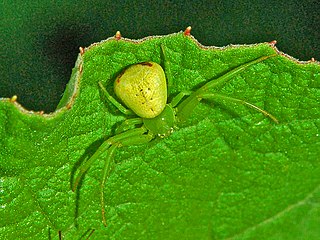
The Thomisidae are a family of spiders, including about 170 genera and over 2,100 species. The common name crab spider is often linked to species in this family, but is also applied loosely to many other families of spiders. Many members of this family are also known as flower spiders or flower crab spiders.

Wolf spiders are members of the family Lycosidae. They are robust and agile hunters with excellent eyesight. They live mostly in solitude, hunt alone, and usually do not spin webs. Some are opportunistic hunters, pouncing upon prey as they find it or chasing it over short distances; others wait for passing prey in or near the mouth of a burrow.

Latrodectus is a broadly distributed genus of spiders with several species that are commonly known as the true widows. This group is composed of those often loosely called black widow spiders, brown widow spiders, and similar spiders. However, the diversity of species is much greater. A member of the family Theridiidae, this genus contains 34 species, which include several North American "black widows". Besides these, North America also has the red widow Latrodectus bishopi and the brown widow Latrodectus geometricus, which, in addition to North America, has a much wider geographic distribution. Elsewhere, others include the European black widow, the Australian redback spider and the closely related New Zealand katipō, several different species in Southern Africa that can be called button spiders, and the South American black-widow spiders. Species vary widely in size. In most cases, the females are dark-coloured and can be readily identified by reddish markings on the central underside (ventral) abdomen, which are often hourglass-shaped.

Orb-weaver spiders are members of the spider family Araneidae. They are the most common group of builders of spiral wheel-shaped webs often found in gardens, fields, and forests. The English word "orb" can mean "circular", hence the English name of the group. Araneids have eight similar eyes, hairy or spiny legs, and no stridulating organs.

Gasteracantha is a genus of orb-weaver spiders first named by Carl Jakob Sundevall in 1833. Species of the genus are known as spiny-backed orb-weavers, spiny orb-weavers, or spiny spiders. The females of most species are brightly colored with six prominent spines on their broad, hardened, shell-like abdomens. The name Gasteracantha is derived from the Greek gaster (γαστήρ), meaning "belly, abdomen", and akantha (άκανθα), meaning "thorn, spine". Spiny-backed orb-weavers are sometimes colloquially called "crab spiders" because of their shape, but they are not closely related to the true crab spiders. Other colloquial names for certain species include thorn spider, star spider, kite spider, or jewel spider.

Myrmecium is a genus of ant-mimicking corinnid sac spiders first described by Pierre André Latreille in 1824. The unrelated jumping spider species Synemosyna formica has been mistaken for a member of this genus twice, once by Eugène Simon in 1897 and once by Cândido Firmino de Mello-Leitão in 1932.

Karl Friedrich Theodor Dahl was a German zoologist, and in particular an arachnologist.

Udubidae is a family of araneomorph spiders, most of whose members were formerly placed in the family Zorocratidae, which is no longer accepted.
This page lists all described species of the spider family Viridasiidae accepted by the World Spider Catalog as of December 2020:
Tengella is a genus of false wolf spiders that was first described by Friedrich Dahl in 1901. It is a senior synonym of Metafecenia.

Synema is a genus of spider in the family Thomisidae, found in most parts of the world.

Geolycosa is a genus of wolf spiders first described in 1904.

Hygrolycosa is a genus of wolf spiders first described by Friedrich Dahl in 1908.

Ebrechtella is a genus of crab spiders that was first described by Friedrich Dahl in 1907.
Reinickella is a genus of spiders in the family Thomisidae. It was first described in 1907 by Dahl. As of 2017, it contains only one species, Reinickella xysticoides, found in Java.
Soelteria is a genus of spiders in the family Thomisidae. It was first described in 1907 by Dahl. As of 2017, it contains only one species, Soelteria nigra, found in Madagascar.
Wechselia is a genus of spiders in the family Thomisidae. It was first described in 1907 by Dahl. As of 2017, it contains only one species, Wechselia steinbachi, found in Argentina.

Megadictynidae is a family of araneomorph spiders first described by Pekka T. Lehtinen in 1967. They are endemic to New Zealand.

Gasteracantha hecata is a species of spider in the spiny orb-weaver genus Gasteracantha. It occurs in the Philippines and has prominent horn-like spines on its abdomen.













